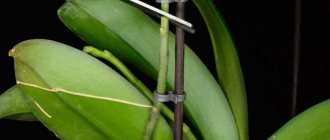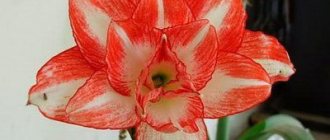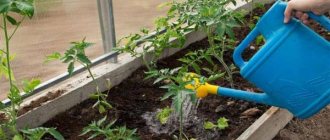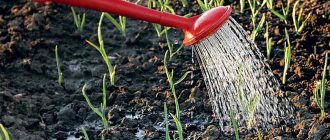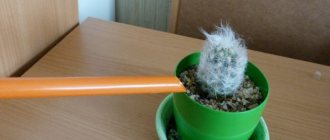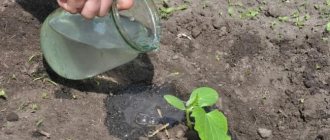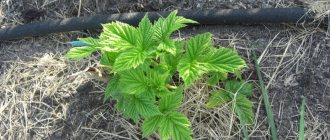How to properly water an orchid during flowering
All types of orchids grown indoors bloom for a long time if they are properly cared for. During flowering, the orchid needs to be watered more often than during other periods of life. Therefore, you need to pay special attention to watering a blooming orchid.
Water the flowering plant more often, otherwise the flowers and buds may begin to fall off due to lack of moisture.
How often should an orchid be watered during flowering? If it is enough to water non-flowering orchids weekly, then during flowering the frequency of watering increases. It is correct to water the orchid during flowering - at least 2 times a week. On particularly hot days, when air humidity is very low, you can water even 3 times a week.
You need to ensure that the substrate in the pot does not dry out completely. But even during the period when the plant needs moisture in large quantities, it should not be over-watered. Watering a non-blooming orchid is carried out only after the substrate has completely dried.
The flowering plant is not allowed to dry out, but the soil mixture should not remain wet before the next watering, so that rotten areas do not form on the roots. The soil should dry out, but not completely, but remain only slightly moist.
During the period of budding and flowering, watering time is slightly reduced.
This allows you to avoid severe waterlogging of the substrate and the development of fungal diseases. You need to water a blooming orchid at home so that the flower continuously receives a portion of moisture. This is very important, since if there is insufficient moisture, the duration of flowering can be greatly reduced.
The quality of watering can be easily controlled by the color of the orchid roots. If the roots remain white or silvery, the plant has received little moisture. If the roots have turned green, sufficient watering has been carried out.
What happens if you don't water phalaenopsis?
Of course, if you don’t water it at all, it will certainly die. Moreover, it is possible that it will bloom at last. This is the specificity of this plant. When its roots suffer greatly from drying out, it uses its last strength to grow a peduncle and bloom. However, this is not something to be happy about. Flowering will be very short, and after that the plant dies.
But it is important to know that short-term drought does not harm phalaenopsis at all. Excess humidity is much worse for his health than its temporary lack.
We offer a video on how to water orchids:
Ways to water a blooming orchid
There are 4 ways to water an orchid during flowering:
- Top watering;
- Immersion;
- Watering through a tray (bottom watering);
- Warm shower.
When top watering, the orchid is watered from a watering can in the same way as most indoor plants. Water is poured in small portions so that the soil mixture is well saturated with moisture. Stop the process when water begins to flow through the lower holes of the pot into the pan.
This method is not used for all species. To grow many varieties, a coarse-grained substrate is used, which with this method of irrigation is poorly saturated with moisture.
You can water a blooming orchid by immersion - this is the most commonly used watering method. The flower pot is immersed in a container of water up to ¾ of its height. The watering time here depends on the fraction of the substrate and is in the range of 20-60 minutes.
After this, the pot is removed and the excess water is drained. With this method of watering, the soil mixture in the pot is well moistened and subsequently retains moisture for a long time. This type of watering is suitable for all types of orchids, even terrestrial ones growing in ordinary soil.
Bottom watering is used for orchids standing in deep trays. In this case, the trays are filled with water, which is absorbed into the soil substrate through the lower holes in the pot.
Typically, such watering takes much longer than other methods, since the soil must be saturated to the entire thickness to the top. This method has its drawbacks. When using it, the soil is saturated unevenly.
The top part may remain poorly moistened. It is also not suitable for watering young orchids with short roots, but only for specimens with long and well-developed roots.
A warm shower is a method of watering orchids that is close to natural. With this type of watering, turn on warm water with a temperature of 35-37ºC through the shower head and water the flower from above. Not only the leaves, but also the surface of the soil should get under water. After thoroughly moistening the substrate in the pot, you need to remove the remaining water from the axils of the leaves so that rot does not develop there.
What are the dangers of improper watering?
If there are irregularities in watering, the roots will be the first to suffer. Because of this, the leaves begin to fall and wither. Main reasons:
- Too rare. The main factor to rely on is dry soil. If the soil is dry, then you should not wait for a certain time for watering; you need to moisten it immediately. The diameter of the pot can also affect the frequency. In a large flowerpot, the substrate dries out more slowly. Because of this, small flowerpots are better for phalaenopsis, so the rhizome does not rot. Rare watering leads to drying of the roots.
- Too frequent. For good growth and development there must be all the necessary conditions. They should resemble a tropical climate. Water correctly so that the soil mixture dries well between sessions. If watering is uncontrolled, the plant will rot. To avoid rotting, it is necessary to periodically water it with a solution of potassium permanganate.
The plant accumulates moisture with the help of its roots. If they do not get enough moisture, then such a crop will not be able to bloom. During flowering, insufficient watering leads to the death of flowers, and then the entire phalaenopsis.
Is it necessary to spray a flower during flowering?
Orchids grow and bloom well in high humidity conditions. Typically, humidity is increased by spraying the plant. Therefore, orchids can be sprayed at any time, even during flowering, especially if the air humidity is very low.
Orchids are sprayed with warm, settled water through a sprayer. Moisture should reach the leaves of the plant. After spraying, it is necessary to remove water from the axils of the leaves with a paper napkin to eliminate the possibility of rotting.
When spraying a blooming orchid, you need to be extremely careful. Drops of water should not fall on flowers and buds.
If it is not possible to carefully spray the plant, it is better to avoid moisturizing in this way altogether. To humidify the air around the plant without spraying, place the flower pot in a deep tray with a damp substrate at the bottom. Pine bark, moss, brick chips or expanded clay are placed in the tray.
How to properly water flowering orchids of certain species
Methods of watering different types of orchids differ due to the conditions under which the plants are kept and the soil substrate they require. During flowering, different types of orchids should be watered as follows:
- Phalaenopsis. The species requires planting in a coarse-grained substrate. You need to water the Phalaenopsis orchid during flowering by immersing it in warm water for 20-40 minutes. Feed during watering. Periodically water with a warm shower;
- Dendrobium is watered only by immersion in warm, settled water. The pot is kept in water for 30-60 minutes, after which it is removed and the excess water is drained;
- Cattleya. This species requires planting a fine fraction in the soil. Water it as the substrate dries. Top watering is carried out, but make sure that water does not fall on the shoots of the plant. Watering with a warm shower can be done once a month or less. This species can also be watered through a tray;
- Wanda . This unusual species is often grown with its root system exposed. In this case, the plant simply hangs on the window or stands in a large empty vase without soil. In this case, the vanda is watered weekly or even more often by immersing the root system in water for 20-30 minutes. You can alternate between immersing and watering with a warm shower. When growing a plant in a vase, simply pour water into it to cover the roots. After 20-30 minutes, drain the water from the vase;
- Cambria, more than other species, needs the soil to dry out between waterings, since its roots are susceptible to rotting. Therefore, it is watered even during flowering once a week. Watering is carried out by immersing the pot 1/3 in a container of water. After 20 minutes, remove the pot and drain off excess water;
- Oncidium . The watering regime of oncidium is closely related to its flowering. It is watered abundantly using the immersion method after growth begins, when a sprout appears from the lower thickened part of the stem (pseudobulb). As the plant grows, it forms one or more new pseudobulbs. At the beginning of their formation, watering is stopped until flower stalks appear near the growing pseudobulbs. After this, watering the flower is resumed;
- Precious orchids. These are terrestrial plants that do not live in an orchid substrate, but in an ordinary loose earthen mixture. Water them from above or through a tray. Immersion watering is also possible.
Phalaenopsis
Cattleya
Wanda
Cumbria
Oncidium
Precious orchids
Basic mistakes when watering plants
When watering an orchid, you must observe:
- Watering time;
- Frequency of moisturizing;
- Duration of watering.
Experts recommend watering orchids in the morning. This watering regime is associated with changes in daily temperature in the homeland of these plants. In the wild, after morning humidification, the air temperature rises and the plant begins to absorb moisture. In the evening the air temperature drops noticeably. By this time, the substrate should already be slightly dry, because the roots of the plant at low temperatures are not able to absorb water.
Watering in the evening is a mistake, since at this time of day the orchid does not “drink.” Its roots will remain in waterlogged soil for a long time, which is very harmful for the plant.
How often should an orchid be watered? Usually they focus not on days or weeks, but on the speed of drying of the substrate. It dries unevenly; it may already be dry on top, but still very moist in the middle of the pot. Watering at this time will be a serious mistake, since stagnation of water in the pot is unacceptable for most types of plants, and is destructive for orchids.
Experienced gardeners focus on the weight of the pot. They estimate the weight of the plant pot after watering. When this pot becomes noticeably lighter, water it. There is no need to weigh the flower on a scale. Its weight can be estimated simply by holding the plant in your hand.
Most types are watered by immersing the pot in water. It would be a mistake to completely immerse the pot with the substrate in water. It is usually ¾ immersed, and only a few types of orchids (cambria) are watered by 1/3 immersion. Keep the substrate in water until it is soaked.
It’s important not to overdo it, but also not to remove the pot too quickly. The duration of watering depends on the specific type of plant.
A common watering mistake is getting water on the shoots or even the orchid flowers. They need to be watered very carefully. Water from the leaf axils and flowers can be easily removed with a regular paper napkin.
What water is suitable for watering phalaenopsis
What kind of water to water phalaenopsis is quite important. Ideally, the water should be clean, settled, and at room temperature. It is good to use rain, distilled or boiled water. However, in practice, not every gardener is ready to provide his plant with such water for irrigation.
Ordinary tap water that has stood for a sufficient time will not cause any harm to the flower. The only exceptions are water that is too hard, as well as water of very low quality, with a large amount of suspended matter.
Possible consequences of improper care
Orchids react sharply to mistakes in their care. This reaction does not appear immediately. But when the consequences of improper care become visible, the plant, as a rule, cannot be saved. Here are the manifestations of the most common mistakes in keeping orchids:
- Leaves lose turgor . The reason is dehydration of the plant due to insufficient watering, low air humidity or damage to the root system;
- Blistering on the leaves is swelling of the leaf tissue due to excessive watering. Watering should be reduced, watering only after the substrate has dried;
- Rotting of the top leaf or growing point is a fungal disease caused by water entering the core of the plant. If the rot has not yet affected the growth point, the indoor flower can be saved by removing the rotten tissue and drying the core;
- Yellowing of orchid leaves is a natural process if only the lowest leaf turns yellow and dies. But if the process occurs en masse, the reason for this is most likely damage to the roots or their rotting. In some cases, yellowing of leaves may occur from a lack of iron or potassium;
- Depressed areas of the leaves of the flower indicate prolonged contact of the leaf blade with water. This can happen after a large amount of water gets on the leaves when watering or spraying. This is also possible when watering by immersion, if the leaves are lowered into the water;
- When direct sun hits the leaves of the plant, sunburn occurs. They can be of various types. Most often there are dry spots with a dark rim, but there are also burns in the form of black spots with a yellow rim or simply light areas of an indeterminate shape.
